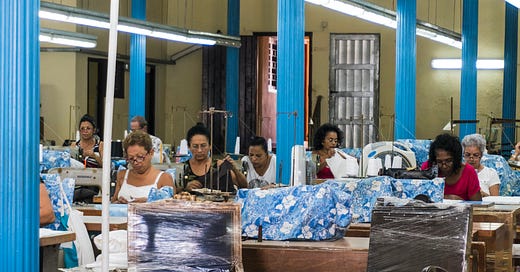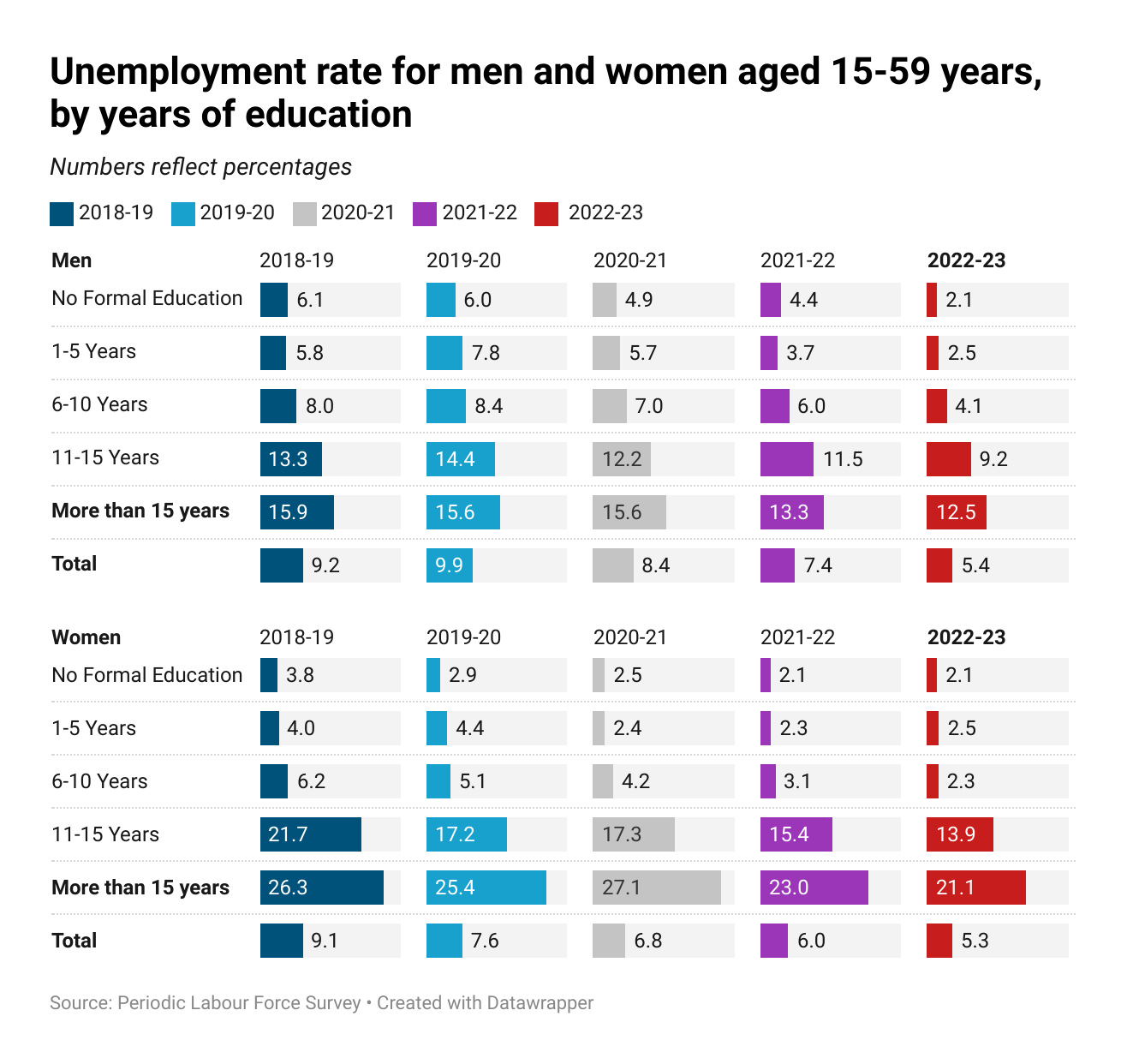Women & Work - all you need to know from November 2023
News, research, data, and recommendations about women and work - curated by our team
Hello, and welcome to CEDA’s newsletter ‘Women & Work’!
In this month’s edition, we bring you news updates about new research on women’s representation in STEM and in new-age gig jobs, the possibilities offered by start-ups, along with some insightful research from Latin America on how women from unlucky cohorts may end up becoming lucky in the long-term, and a throwback to a historic milestone.
We hope you will enjoy reading the edition. You can access previous editions of this newsletter here.
To everyone who is new here: At the Centre for Economic Data and Analysis (CEDA), we are working on an ambitious project to understand and find ways to overcome the demand-side barriers that are keeping women out of the workforce.
We are curating ‘Women & Work’ with the hope that it can provoke, stimulate and amplify conversations about women’s participation in paid work in India. Please do share this edition on your social media, and with your friends, family and colleagues. Thank you!
🗞️In The News
Women soldiers, sailors and air warriors in the Indian Armed Forces will now be eligible for maternity, child care and child adoption leaves on a par with their officer counterparts. Women officers in the three services are eligible for 180 days of maternity leave, 30 days of leave in the instance of a miscarriage or abortion, and 180 days of leave in case they adopt a child below the age of one year. Read more in The Indian Express here.
Over a third (35 percent) of all science, technology, engineering and mathematics (STEM) conferences held in India between June 2020 and March 2023 had no women speakers, researchers Shruti Muralidhar and Vaishnavi Ananthanarayanan have found, Nature reported. Not only are women under-represented among STEM faculty, their under-representation was even more skewed on the conference circuit, the researchers noted further. Read more here.
Razorpay, a fintech company based in Bengaluru, has launched a ‘Resume with Razorpay’ programme for women on career breaks looking to return to the workforce, The Economic Times reported. Under the programme, women who have been on a career break for two years or more will be offered six-month internship programmes to facilitate their return to work. Read more here.
Women’s participation in blue-collar jobs saw a 35-40 percent jump post the Covid-19 pandemic, but they continue to comprise only 14-15 percent of the blue-collar workforce in India, research by Entitled Solutions, a platform advocating for inclusive workplaces, has found. Based on a survey of 10,000 women, the research further noted that women remain almost absent from new-age gig economy jobs where they form just 1 percent of the workforce.
Start-ups may offer greater professional opportunities to women as compared to established corporates, new research by ACT grants in collaboration with LEAD at Krea University, The Udaiti Foundation and McKinsey highlights. This is because start-ups allow more room for faster career progression, greater autonomy and flexibility, allowing women the ability to meet personal and professional goals at different life stages, the research highlights. Read more here.
💡Research Spotlight
What happens to the long-term professional trajectories of young workers who enter the labour force during times of crises?
Well, members of such “unlucky” cohorts often end up staying unlucky beyond the crisis years — research evidence suggests that tough economic conditions at the time of entry into the workforce can have a lasting negative effect on labour market outcomes (Von Wachter, 2020).

In a research paper published earlier this year, Inés Berniell and her co-authors show that this kind of impact plays out slightly differently in the context of the emerging economies as compared to the more advanced ones, especially when examined through a gender lens.
While men who entered the workforce during times of high unemployment suffered negative outcomes in the labour market a decade later, among women the case was the opposite. Women from such “unlucky cohorts” actually had higher chances of being employed and of earning higher wages a decade after their entry into the workforce, find the authors.
Berniell et al. base their observations on a synthetic panel of more than 1.5 million individuals from national household surveys in 15 Latin American countries.
This seems to be specific to developing economies, the researchers note, since similar research in advanced economies does not find any difference between the long term impact of entering the workforce during tough economic times on men and women’s labour market outcomes.
So why does this happen?
“The Added Worker Effect” (AWE), say Berniell et al, along with empowerment and changes in perception.
AWE refers to the phenomenon when an additional member of the household enters the labour force during hard times to bring in additional income. Often the additional worker happens to be the women of the household who may not be part of the labour force during stable, good economic times. (We saw this, most recently during Covid-19, for example.)
Berniell et al further explore household data on values and perceptions and find that women who entered the labour force during times of high unemployment end up controlling a larger share of household income, and are more likely to become the heads of their households compared to women from other cohorts. Among men, the opposite happens. The authors also note a corresponding shift in social perceptions on gender roles. So the crisis may push them to enter the labour force, but the empowerment that comes consequently, and change in social perceptions enable them to stay in.
The authors observe:
“For young women in the typical age of the school-work transition, economic downturns may act as an additional incentive to enter the labour market in order to help their families.
“This unexpected entry may have long-lasting positive consequences on the labour market attachment and earning perspectives of young women through various channels, including increased human capital, change in perceptions and empowerment. In other words, the negative shock might end up being beneficial to these ‘lucky women’ in ‘unlucky cohorts’.”
Read the full paper here.
📊Datapoint
On the face of it, a similar proportion of Indian men and women aged 15-59 were unemployed in 2022-23. However, breaking it down by levels of education reveals a more sobering picture. Across India, unemployment remains a serious concern, especially for those with more education. And among women, this is even more severe. Over a fifth (21.1 percent) of women in this age group who had 15 or more years of education were unemployed in 2022-23. Among men, the corresponding share was 12.5 percent. (Analysis: Kulvinder Singh/CEDA)
👍 CEDA Recommends
This edition’s recommendations have been curated especially for our readers by Suraj Shekhar, Assistant Professor of Economics at Ashoka University.
What’s an essential academic work that you would recommend to someone who is just getting started with working on the subject of female labour force participation?
Suraj Shekhar: This is not really my area but let me point to a very interesting article with a general point. Coate and Loury’s 1993 paper (Will Affirmative-Action Policies Eliminate Negative Stereotypes?) shows how stereotypes can become self-fulfilling prophecies. The interesting thing about the paper is that the players in the game have no malice towards any group, they just have skewed beliefs about the capabilities of different groups (think men vs women). One would imagine that their beliefs would be corrected over time but sadly things are not so easy.
Anything published in the news media recently that shed light on an important aspect about women’s work in India?
This article by the People’s Archive of Rural India (PARI) presents glimpses into the lives of many working women and highlights how these women try to find pockets of leisure in their incredibly demanding social, working and personal lives.
Is there a film that you can recommend which, in your opinion, does a good job of portraying the world of work from a gender lens?
The Queen’s Gambit - For those who play and follow the goings on in the world of chess, it was absolutely astonishing to see the impact of this show on the popularity of chess worldwide. Perhaps not as big, but it could be likened to how the Harry Potter books affected readership! The show follows the life of a young girl as she overcomes her personal demons to become the world champion in a sport which is overwhelmingly dominated by men even now.
And a book that did the same?
I love the writing of Chimamanda Ngozi Adichie! It has been a while since I read it, but her novel Americanah presents a brilliantly written story of a young Nigerian woman and how she deals with race, immigration, personal and cultural issues on her journey to becoming a unique writer.
⏳Throwback
Fifty years ago, a historic development took place on American soil.
Margaret Court not only won the women’s US Open championship (one of the four grand slams in tennis) for the fifth time, she also received the same prize money as John Newcome, the men’s champion for the year. This became the first time the tournament awarded equal prize money to the winners of the men’s and women’s championship.
But this was no act of charity on the part of the tournament.
A year before, in 1972, after Billie Jean King won the US Open and received a much smaller pay-cheque as compared to her male counterpart, she threatened the tournament that she (and other women pros) would not be back if the tournament didn’t fix this glaring gap.

This was no casual demand or easy threat to make.
Different (and lesser) award money for female athletes was the norm across all sports – not just tennis – at the time. But King’s conviction and gamble paid off.
In the following year, the US Open became the first sporting tournament to offer equal award money to male and female players. The other three grand slams followed later. While many other sports championships have done so too over the years, equal prize money is still not a universal trend across them all.
Reflecting on the historic milestone earlier this year, King recalled:
"When we first started ... the media would come to us and go, 'Billie, you can't imagine growing [women's tennis] that much can you?...
"I said, 'Oh, no, no, no. We're going to grow a lot. We're going to be global. We're going to make millions and millions of dollars.”
Truly a legend in more ways than one! Read more here.
That’s all from us for this edition. Thank you for reading! We will see you next month. In the meantime, if you have feedback, questions, tips, or just want to say hello, feel free to do so by replying to this email, or drop in a word at editorial.ceda@ashoka.edu.in
Curated by: Akshi Chawla for the Centre for Economic Data & Analysis (CEDA), Ashoka University. Cover illustration: Nithya Subramanian










